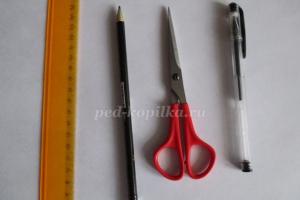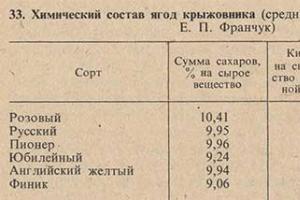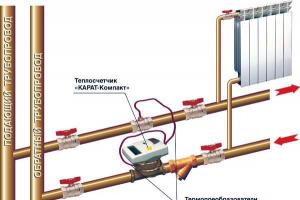Regardless of why a person needs a magnet, it can easily be made at home. When such a thing is at hand, with its help you can not only have fun lifting various small pieces of iron from the table, but also find it useful application, for example, finding a needle dropped on the carpet. In this article you will learn how easy it is to make an electromagnet with your own hands at home.
A little physics
As we remember (or don’t remember) from physics lessons, in order to transform electricity into a magnetic field, you need to create induction. Inductance is created using an ordinary coil, inside which this field arises and is transmitted to the steel core around which the coil is wound.
Thus, depending on the polarity, one end of the core will emit a field with a minus sign, and the opposite end will emit a field with a plus sign. But visual magnetic abilities are not affected in any way by polarity. So, when you are done with physics, you can begin decisive action to create a simple electromagnet with your own hands.
Materials for making the simplest magnet

First of all, we need any inductor with a copper wire wound around the core. This can be a regular transformer from any power supply. An excellent way to create electromagnets is to wind them around the narrowed back of picture tubes of old monitors or televisions. The conductor threads in transformers are protected by insulation consisting of an almost invisible layer of special varnish that prevents the passage of electric current, which is exactly what we need. In addition to the indicated conductors, to create an electromagnet with your own hands you also need to prepare:
- A regular one and a half volt battery.
- Scotch tape or tape.
- Sharp knife.
- Hundreds of nails.
The process of making a simple magnet

We start by removing the wires from the transformer. As a rule, its middle is located inside the steel frame. You can, after removing the surface insulation on the coil, simply unwind the wire, dragging it between the frames and the coil. Since we don't need a lot of wire, this method is the most acceptable here. When we have released enough wire, we do the following:
- We wind the wire removed from the transformer coil around a nail, which will serve as a steel core for our electromagnet. It is advisable to make turns as often as possible, pressing them tightly against each other. Do not forget to leave a long end of the wire at the initial turn, through which our electromagnet will be powered to one of the poles of the battery.
- When we reach the opposite end of the nail, we also leave a long conductor for powering. We cut off the excess wire with a knife. To prevent the spiral we wound from unraveling, you can wrap it with tape or tape.
- We strip both ends of the wire coming from the wound nail from the insulating varnish with a knife.
- We lean one end of the stripped conductor against the positive of the battery and secure it with tape or tape so that the contact is well maintained.
- We wind the other end to the minus in the same way.

The electromagnet is ready for use. By scattering metal clips or tacks on the table, you can check its functionality.
How to make a more powerful magnet?

How to make an electromagnet with more powerful magnetic properties with your own hands? The strength of magnetism is influenced by several factors, and the most important one is the electrical current of the battery we use. For example, by making an electromagnet from a square 4.5 volt battery, we will triple the strength of its magnetic properties. The 9-volt crown will give an even more powerful effect.
But do not forget that the stronger the electric current, the more turns will be required, since the resistance with a small number of turns will be too strong, which will lead to strong heating of the conductors. If they are heated too much, the insulating varnish may begin to melt, and the turns will begin to short-circuit to each other or to the steel core. Both will sooner or later lead to a short circuit.
Also, the strength of magnetism depends on the number of turns around the magnet core. The more there are, the stronger the induction field will be, and the stronger the magnet will be.
Making a more powerful magnet
Let's try to make a 12 volt electromagnet with our own hands. It will be powered by a 12-volt AC power supply or a 12-volt car battery. To manufacture it, we will need a much larger amount of copper conductor, and therefore we should initially remove the internal coil with copper wire from the prepared transformer. Bulgarian - the most excellent remedy to remove it.
What we need for production:
- A steel horseshoe from a large padlock, which will serve as our core. In this case, it will be possible to magnetize the pieces of iron at both ends, which will further increase the lifting capacity of the magnet.
- Coil with copper wire in varnished insulation.
- Insulating tape.
- Unnecessary 12 volt power supply or car battery.
The process of making a powerful 12-volt magnet
Of course, any other massive steel pin can be used as a core. But a horseshoe from an old castle will do just fine. Its bend will serve as a kind of handle if we start lifting loads of impressive weight. So, in this case, the process of making an electromagnet with your own hands is as follows:
- We wind the wire from the transformer around one of the horseshoes. We place the coils as tightly as possible. The curve of the horseshoe will interfere a little, but that's okay. When the length of the side of the horseshoe ends, we lay the turns in the opposite direction, on top of the first row of turns. We make a total of 500 turns.
- When the winding of one half of the horseshoe is ready, wrap it with one layer of electrical tape. The original end of the wire, intended for recharge from a current source, is brought out to the upper part of the future handle. We wrap our coil on the horseshoe with another layer of electrical tape. We wind the other end of the conductor to the bending core of the handle and make another coil on the other side.
- We wind the wire on the opposite side of the horseshoe. We do everything the same as in the case of the first side. When 500 turns have been laid, we also remove the end of the wire for power supply from an energy source. For those who don't understand, the procedure is clearly shown in this video.

The final stage of making an electromagnet with your own hands is recharging to the energy source. If it is a battery, we extend the ends of the stripped conductors of our electromagnet using additional wires, which we connect to the battery terminals. If this is a power supply, cut off the plug going to the consumer, strip the wires and screw a wire from the electromagnet to each one. Insulate with electrical tape. We plug the power supply into the outlet. Congratulations. You have made with your own hands a powerful 12-volt electromagnet that is capable of lifting loads over 5 kg.
In order to make a strong electromagnet, take an excellent magnetic core, wrap it with an insulated conductor and connect it to a current source. The power of this electromagnet and can be regulated by different methods.
You will need
- piece of low carbon electrical steel cylindrical, alienated copper wire, continuous current source.
Instructions
1. Take a piece of electrical steel and carefully wrap it, turn by turn, with insulated copper wire. Take a wire of medium cross-section, so as to accommodate as many turns as possible, but at the same time not too thin, so that it does not burn out from large currents.
2. Later, connect the wire to a continuous current source through a rheostat, if there is no way to regulate the voltage in the source itself. For such a magnet, a source that produces up to 24 V is absolutely sufficient. After this, move the rheostat slider to the highest resistance or the source regulator to the minimum voltage.
3. Increase the tension slowly and carefully. In this case, a characteristic vibration will appear, accompanied by a sound, the one that can be heard when the transformer is operating - this is typical. Be sure to monitor the temperature of the winding, since the duration of operation depends on it electromagnet A. Raise the voltage to the point where the copper wire begins to visibly heat up. After this, turn off the current and allow the winding to cool. Turn on the current again and, with the help of such manipulations, find the highest voltage at which the conductor will not heat up. This will be the nominal operating mode of the done electromagnet A.
4. Bring a body made of a substance that contains steel to one of the poles of a working magnet. It should be firmly attracted to the nickel of the magnet (we consider the nickel to be the base of the steel core). If the attractive force is unsatisfactory, take a wire with a longer length and apply turns in several layers, proportionally increasing the magnetic field. In this case, the resistance of the conductor will increase, and its adjustment will need to be carried out again.
5. To make a magnet attract better, take a horseshoe-shaped core and wrap wire around its straight sections - then the surface of attraction and its strength will increase. To increase the attractive force, make a core from an alloy of iron and cobalt, conductivity magnetic field which is slightly higher.
People noticed a long time ago that when an electric current is passed through a coil wound of metal wire, a magnetic field is created. And if you place some metal, ferromagnetic (steel, cobalt, nickel, etc.) inside this coil, then the effectiveness of the magnetic field increases hundreds, or even thousands of times. That's how it came into being electromagnet, one that is still a necessary part of many electrical devices today.

You will need
- Nail, pliers, enameled wire, cambric (wire insulation), power source, paper, electrical tape.
Instructions
1. Take a thick nail and use pliers to bite off the sharp tip. File the cut area so that the end of the nail is even and smooth. After that, burn it in the oven, let it cool in the air and clean off the carbon deposits.
3. Take the enameled wire and wind it tightly, turn to turn, onto the cambric; when you have wound one layer, wrap it in paper and wind the next one. The more turns you wind, the greater the effectiveness will be. electromagnet A. After finishing winding, bring the wires out, wrap the final layer of winding with paper and wrap it with electrical tape. Clean the ends of the wires from the enamel and connect them to a power source, electromagnet will attract metal objects.
Video on the topic
Note!
Do not connect the nail-based electromagnet to a mains voltage of 220 volts.
Helpful advice
If you use continuous current, the results will be greater. For alternating current, it is appropriate to make the core made from electrical steel, say from an old transformer, in order to minimize the eddy currents arising in it. The larger the core area, the more effective the electromagnet.
Source current is a device where energy of some kind is reformed into electrical energy. Work takes place in it, which is based on the distribution of correctly and negatively charged particles accumulating at the poles of the source.

You will need
- carbon rod, ammonia, paste, zinc vessel, galvanized steel, table salt, baking soda, coins, lemon, apple, voltmeter, galvanometer
Instructions
1. Make a chemical source current, in which due to chemical reactions there will be a reformation of internal energy into electrical energy. An example of this is a galvanic cell, where a carbon rod is inserted into a zinc vessel.
2. Place the rod in a linen bag and fill it in advance with a mixture of coal and manganese oxide.
3. Use a flour paste on the solution in the element ammonia. During the interaction of zinc with ammonia, the carbon rod acquires the correct charge, and the zinc becomes negative. Between the zinc vessel and the charged rod there will be electric field. In this source current The positive electrode will be the carbon, the negative electrode will be the zinc vessel.
4. Make a battery by combining several similar galvanic cells. Sources current On this basis, they are used in UPSs, as well as in independent household electrical appliances. They are used to produce batteries for cars, electric vehicles and cell phones.
5. Take electric lamp without a glass container, screw it into a cartridge mounted in advance on a stand. Combine with a galvanometer. If you heat the junction of the spiral with the wire with a match, the device will indicate the presence current .
6. Take an apple or lemon and stick a copper wire into it. Attach galvanized steel at a small distance. The result is a battery, i.e. galvanic cell. If you measure the voltage on this battery with a voltmeter, it will be about 1 V. You can also make a huge battery by connecting the elements in stages.
7. Take five “white” and “yellow” coins. Arrange them alternating between each other. Place between them gaskets made of newspaper, previously soaked in a solution of traditional table salt. Place them in a column and squeeze. By connecting a voltmeter to the first “white” and last “yellow” coin, you can find the voltage, and if you touch it, you can even get a slight electric shock. All metal parts should be cleaned of grease in advance.
Video on the topic
Creating strong electro magnets- This is a difficult technical task. In industry, as well as in Everyday life Magnets of enormous power are needed. In a number of countries, magnetic levitation trains are already operating. Cars with electromagnetic motors will soon appear in large quantities in our country under the Yo-mobile brand. But how are high-power magnets created?

Instructions
1. It’s worth noting right away that magnets are divided into several classes. There are continuous magnets - these are, as usual, pieces of a certain metal and alloy that have a certain magnetism without outside influence. And there are also electromagnets. This technical devices, in which a magnetic field is created by passing an electric current through special coils.
2. From continuous magnets Only neodymium can be classified as strong. Although relatively small in size, they have primitively stunning magnetic collations. Firstly, they lose their magnetic properties by only 1% per hundred years. Secondly, with relatively small sizes, they have great magnetic force. Neodymium magnets are made unnaturally. To create them you need the rare earth metal neodymium. Steel and boron are also used. The resulting alloy is magnetized in a magnetic field. As a result, the neodymium magnet is ready.
3. In industry, strong electromagnets are used everywhere. Their design is much more difficult than that of continuous magnets. To create a strong electromagnet, you need a coil consisting of a winding of copper wire and an iron core. The strength of the magnet in this case depends only on the strength of the current passed through the coils, as well as the number of turns of wire on the winding. It is worth noting that at a certain current strength, the magnetization of the iron core undergoes saturation. Consequently, the strongest industrial magnets are made without it. Instead, a certain number of turns of wire are added. In most strong industrial magnets with an iron core, the number of turns of wire rarely exceeds ten thousand per meter, and the applied current is 2 amperes.
Virtually everyone House master I began my acquaintance with physics in childhood with the construction electromagnet. If your son is growing up, the time has come for him to assemble this simple device together with you, after which he will probably become interested in science and technology and in the future will also become a home master. And it will probably be interesting for you to remember your childhood.

You will need
- Several meters of insulated wire
- Insulating tape
- Nail
- Soldering iron, solder and neutral flux
- Wire cutters
- Two AA batteries and battery compartment
- Bulb 3.5 V, 0.26 A
- Switch
- Paper clips
Instructions
1. Take a nail and wrap it with a layer of electrical tape so that only the head remains exposed.
2. Take a few meters of insulated wire and wrap it around the nail.
3. Strip the ends of the wire. Combine the battery compartment, the lamp and the resulting electromagnet in steps.
4. Insert batteries into the battery compartment and turn on the switch. The lamp will light up.
5. Make sure that the nail begins to attract the paper clips.
6. The nail is made of soft magnetic steel. This means that even if it saves residual magnetization, it does not last long. Once you turn off the electromagnet, it will quickly lose its ability to attract paper clips. There are also hard magnetic steels. A product made of such steel, once magnetized, retains this quality for a long time.
7. Magnet with support electromagnet paperclip It should retain magnetization longer than a nail. A screwdriver saves it even longer. In some cases, a magnetized screwdriver is much more comfortable than a non-magnetized one. But keep in mind that not everyone likes to use such screwdrivers. Some home craftsmen, on the contrary, find magnetized screwdrivers very inconvenient.
8. Try this skill. Bring a paper clip to an electromagnet and it will be attracted to it. Bring another paper clip to this one, and another one to it, thereby making a chain of paper clips. The paper clips will stick to each other until you turn off the electromagnet. After turning it off, the chain of paper clips will quickly disintegrate.
9. The speed of magnetization and demagnetization of steel products is affected by mechanical influences. Make sure of it this way. Turn on the electromagnet, lightly tap the nail head, and then turn it off. The magnetization will last a little longer. If you knock on the head of a nail when the electromagnet is turned off, it will demagnetize more quickly.
10. Apply a continuous magnet that has approximately the same strength as the electromagnet to an electromagnet. Make sure that opposite poles of magnets attract, and like poles repel. Reversing the power polarity electromagnet, you will find that its poles have also swapped places.
11. Please note that, being turned on through an electromagnet, the lamp slowly gains brightness, and when the switch is opened, a spark jumps between its contacts, which is not tracked without electromagnet. This manifests itself as so-called self-induction. Your son will learn about what this is in high school in physics classes, or, if it’s more interesting to him now, he’ll read it on the Internet.
Note!
Do not connect the electromagnet to the batteries directly, without a lamp. Do not touch the bare ends of the wires when the electromagnet is turned off, so as not to be shocked by self-induction voltage.
Video on the topic
IN household periodically required different instruments. Often you have to make various devices with your own hands, including an electromagnet. This device removes metal shavings very effectively and makes it easy to find small metal objects. Sometimes home craftsmen just want to experiment, remembering their knowledge from the school physics course.
Electromagnet device
A classic electromagnet is a device in which an electric current passes through it. In the simplest electromagnet, such a field can form even around an ordinary conductor if it is energized.
The circuit of the simplest electromagnet includes a ferromagnetic core with a wound winding. When electric current flows through the winding, a powerful magnetic field is formed in the core. To perform mechanical actions, the structure is equipped with a moving part called an anchor. Aluminum or copper insulated wire is used for winding. This circuit diagram is the basis for creating similar electromagnets with your own hands at home.
Making an electromagnet at home
To make an electromagnet with your own hands, you first need to select the material for the core. The simplest and suitable option there will be a nail large sizes, length from 100 to 200 mm. It must first be heated very much, and then allowed to cool and cleaned of scale. After this, the nail is bent exactly in half, and the head and tip are sawed off with a hacksaw.
The second stage will be making the coil. The design of the reel includes the following elements: a rectangular paper neck (48x37 mm), paper stop rims (48x3 mm) and round cardboard rims with a hole in the middle. Their outer and inner diameters will be 19 and 7 mm, respectively. 
After preparing the parts, you can begin assembling the electromagnet. The neck on the narrower side is wound loosely around the nail and fixed with glue. Next, cardboard rims are put on the lower and upper parts of the neck. The thrust rims are lubricated with glue, wound around the edges of the neck and glued to the rims. The glue should dry well in all areas.
A wire approximately 15-20 meters long is suitable for winding. The wire is wound onto a reel so that ends of 10 centimeters remain at the edges. The winding must be even so that all turns fit tightly together. The power of the future electromagnet completely depends on this. The greatest difficulty lies in winding the first layer. Each finished row is wrapped in two layers of thin paper. At the end of the winding, the entire coil is wrapped on top with electrical tape. The remaining ends of the winding must be stripped for further connection.
All that remains is to attach the switch and battery to the resulting structure. Thus, the electromagnet will be completely made with your own hands.
How to make an electromagnet?
An electromagnet is a fairly simple device that can be used both for entertainment and for building all kinds of electrical diagrams. In this article we will talk about how to make an electromagnet with your own hands at home. For this we do not need any special knowledge of physics or complex components.
What do we need
In order to create an electric magnet, we will need: an iron nail, a coil copper wire, power supply or battery, switch, scissors and soldering iron. Let us immediately note that you should not take too thick wire; it is better to choose products with a medium diameter. As for the size of the nail, there is no fundamental difference; it all depends on your ultimate goals. Moreover, if you don't have a nail, you can find something similar. For example, some kind of metal rod. We also draw your attention to the fact that the main thing in a rod or nail is its shape. Curved products are not suitable for us.
How to make a powerful electromagnet: instructions
The first step is to take our nail and carefully wrap the wire around it. It is important that each turn fits tightly and evenly to each other. We make approximately 3-4 layers of wire. Be as careful as possible, because if you break the wire, you will have to start all over again. The next step is to bring out the two ends of the wound wire and connect them to the battery. If you wish, you can add a switch to the circuit, this will simplify working with the magnet. Next, we carefully solder everything. Now your electromagnet is ready!
Principle of operation
An electric magnet works very simple principle. When current is applied to the coil, it becomes magnetized and begins to “magnetize” metal elements. The power of the product you make is directly proportional to the number of turns and layers of copper. Thus, the more copper you wind, the more powerful your magnet will be. If you encounter any difficulties during manufacturing, watch how to make an electromagnet on video on the Internet.
An electromagnet is an artificial magnet in which a magnetic field arises and is concentrated in a ferromagnetic core as a result of the passage of electric current through the winding surrounding it, i.e. When current is passed through the coil, the core placed inside it acquires the properties of a natural magnet.
The scope of application of electromagnets is very wide. They are used in electrical machines and devices, in automation devices, in medicine, and in various types of scientific research. Most often, electromagnets and solenoids are used to move some mechanisms, and in industries to lift loads.
For example, a lifting electromagnet is a very convenient, productive and economical mechanism: no maintenance personnel are required to secure and release the transported cargo. It is enough to place an electromagnet on the moving load and turn on the electric current in the electromagnet coil and the load will be attracted to the electromagnet, and to release the load you only need to turn off the current.
The design of an electromagnet is easy to replicate and is essentially nothing more than a core and a coil of conductor. In this article we will answer the question of how to make an electromagnet with your own hands?
How an electromagnet works (theory)
If an electric current flows through a conductor, a magnetic field is formed around this conductor. Since current can only flow when the circuit is closed, the conductor must be a closed loop, such as a circle, which is the simplest closed loop.
Previously, a conductor rolled into a circle was often used to observe the effect of current on a magnetic needle placed in its center. In this case, the arrow is at an equal distance from all parts of the conductor, making it easier to observe the effect of the current on the magnet.
To increase the effect of electric current on a magnet, you can first increase the current. However, if you bend a conductor through which some current flows twice around the circuit it covers, then the effect of the current on the magnet will double.
In this way, this action can be increased many times over by bending the conductor an appropriate number of times around a given circuit. The resulting conducting body, consisting of individual turns, the number of which can be arbitrary, is called a coil.

Let's remember the school physics course, namely that when an electric current flows through a conductor. If the conductor is rolled into a coil, the magnetic induction lines of all turns will add up, and the resulting magnetic field will be stronger than for a single conductor.
The magnetic field generated by electric current, in principle, has no significant differences compared to the magnetic field. If we return to electromagnets, the formula for its traction force looks like this:
F=40550∙B 2 ∙S,
where F is the traction force, kg (force is also measured in newtons, 1 kg = 9.81 N, or 1 N = 0.102 kg); B - induction, T; S is the cross-sectional area of the electromagnet, m2.
That is, the traction force of an electromagnet depends on the magnetic induction, consider its formula:

Here U0 is the magnetic constant (12.5*107 H/m), U is the magnetic permeability of the medium, N/L is the number of turns per unit length of the solenoid, I is the current strength.
It follows that the force with which a magnet attracts something depends on the current strength, the number of turns and the magnetic permeability of the medium. If there is no core in the coil, the medium is air.
Below is a table of relative magnetic permeabilities for different media. We see that for air it is equal to 1, and for other materials it is tens and even hundreds of times greater.

In electrical engineering, a special metal is used for cores; it is often called electrical or transformer steel. In the third line of the table you see “Iron with silicon” whose relative magnetic permeability is 7 * 103 or 7000 H/m.
This is the average value for transformer steel. It differs from the usual one precisely in the silicon content. In practice, its relative magnetic permeability depends on the applied field, but we will not go into details. What does the core do in the coil? An electrical steel core will enhance the magnetic field of the coil by approximately 7000-7500 times!
All you need to remember to begin with is that the material of the core inside the coil depends on it, and the force with which the electromagnet will pull depends on it.
Practice
One of the most popular experiments that are carried out to demonstrate the occurrence of a magnetic field around a conductor is the experiment with metal shavings. The conductor is covered with a sheet of paper and magnetic shavings are poured onto it, then an electric current is passed through the conductor, and the shavings change their location somehow on the sheet. It's almost an electromagnet.
But simply attracting metal shavings is not enough for an electromagnet. Therefore, you need to strengthen it, based on the above - you need to make a coil wound on a metal core. The simplest example would be insulated copper wire wound around a nail or bolt.

Such an electromagnet is capable of attracting various pins, scrapies, and the like.

As a wire, you can use either any wire in PVC or other insulation, or copper wire in varnish insulation such as PEL or PEV, which are used for windings of transformers, speakers, motors, etc. You can find it either new in reels, or reeled from the same transformers.

10 Nuances of making electromagnets in simple words:
1. The insulation along the entire length of the conductor must be uniform and intact so that there are no interturn short circuits.
2. Winding should go in one direction, like on a spool of thread, that is, you cannot bend the wire 180 degrees and go in the opposite direction. This is due to the fact that the resulting magnetic field will be equal to the algebraic sum of the fields of each turn; without going into details, the turns wound in reverse side, will generate an electromagnetic field of the opposite sign, as a result the fields will be subtracted and as a result the strength of the electromagnet will be less, and if there are the same number of turns in one and the other direction, the magnet will not attract anything at all, since the fields will suppress each other.
3. The strength of the electromagnet will also depend on the strength of the current, and it will depend on the voltage applied to the coil and its resistance. The resistance of the coil depends on the length of the wire (the longer, the larger it is) and its cross-sectional area (the larger the cross-section, the lower the resistance). An approximate calculation can be made using the formula - R=p*L/S
4. If the current is too high, the coil will burn out
5. With direct current, the current will be greater than with alternating current due to the influence of inductance reactance.
6. When working on alternating current- the electromagnet will hum and rattle, its field will constantly change direction, and its traction force will be less (half) than when operating at a constant one. In this case, the core for AC coils is made of thin sheet metal, assembled into a single whole, while the plates are isolated from each other with varnish or a thin layer of scale (oxide), the so-called. charge - to reduce losses and Foucault currents.
7. With the same traction force, an alternating current electric magnet will weigh twice as much, and the dimensions will increase accordingly.
8. But it is worth considering that alternating current electromagnets are faster than magnets direct current.
9. DC electromagnet cores
10. Both types of electromagnets can operate on both direct and alternating current, the only question is what strength it will have, what losses and heating will occur.
3 ideas for an electromagnet using improvised means in practice
As already mentioned, the easiest way to make an electromagnet is to use a metal rod and a copper wire, selecting both for the required power. The supply voltage of this device is selected experimentally based on the current strength and heating of the structure. For convenience, you can use a plastic spool of thread or the like, and select a core - a bolt or nail - for its internal hole.

The second option is to use an almost finished electromagnet. Think about electromagnetic switching devices - relays, magnetic starters and contactors. For use on direct current and 12V voltage, it is convenient to use a coil from automotive relays. All you need to do is remove the case, break out the moving contacts and connect the power.
To operate from 220 or 380 volts, it is convenient to use coils; they are wound on a mandrel and can be easily removed. Select the core based on the cross-sectional area of the hole in the coil.
This way you can turn on the magnet from the outlet, and it is convenient to regulate its strength if you use a rheostat or limit the current using a powerful resistance, for example.








